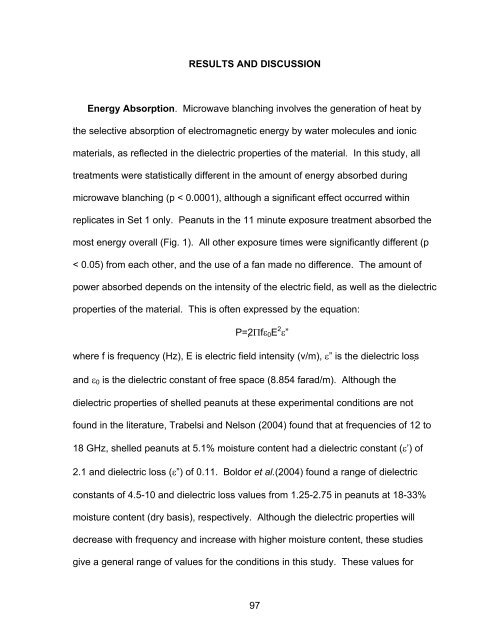Abstract SCHIRACK, ANDRIANA VAIS. The Effect of Microwave ...
Abstract SCHIRACK, ANDRIANA VAIS. The Effect of Microwave ...
Abstract SCHIRACK, ANDRIANA VAIS. The Effect of Microwave ...
Create successful ePaper yourself
Turn your PDF publications into a flip-book with our unique Google optimized e-Paper software.
RESULTS AND DISCUSSION<br />
Energy Absorption. <strong>Microwave</strong> blanching involves the generation <strong>of</strong> heat by<br />
the selective absorption <strong>of</strong> electromagnetic energy by water molecules and ionic<br />
materials, as reflected in the dielectric properties <strong>of</strong> the material. In this study, all<br />
treatments were statistically different in the amount <strong>of</strong> energy absorbed during<br />
microwave blanching (p < 0.0001), although a significant effect occurred within<br />
replicates in Set 1 only. Peanuts in the 11 minute exposure treatment absorbed the<br />
most energy overall (Fig. 1). All other exposure times were significantly different (p<br />
< 0.05) from each other, and the use <strong>of</strong> a fan made no difference. <strong>The</strong> amount <strong>of</strong><br />
power absorbed depends on the intensity <strong>of</strong> the electric field, as well as the dielectric<br />
properties <strong>of</strong> the material. This is <strong>of</strong>ten expressed by the equation:<br />
P=2Πfε0E 2 ε”<br />
where f is frequency (Hz), E is electric field intensity (v/m), ε” is the dielectric loss<br />
and ε0 is the dielectric constant <strong>of</strong> free space (8.854 farad/m). Although the<br />
dielectric properties <strong>of</strong> shelled peanuts at these experimental conditions are not<br />
found in the literature, Trabelsi and Nelson (2004) found that at frequencies <strong>of</strong> 12 to<br />
18 GHz, shelled peanuts at 5.1% moisture content had a dielectric constant (ε’) <strong>of</strong><br />
2.1 and dielectric loss (ε”) <strong>of</strong> 0.11. Boldor et al.(2004) found a range <strong>of</strong> dielectric<br />
constants <strong>of</strong> 4.5-10 and dielectric loss values from 1.25-2.75 in peanuts at 18-33%<br />
moisture content (dry basis), respectively. Although the dielectric properties will<br />
decrease with frequency and increase with higher moisture content, these studies<br />
give a general range <strong>of</strong> values for the conditions in this study. <strong>The</strong>se values for<br />
97

















